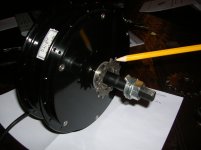"Actually, in my findings, about 80-90% throttle is the most efficient, IF you have the motor spinning around the same percentage of its max RPM. Throttle does not dictate efficiency so much as the motor RPM, at least that was the case with my R/C bike..."
I don't understand how running the controller at 80-90% throttle could be more efficient than running it at 100%. I have my motor geared to my cranks so that at WOT I am spinning at 80 rpm cadence, at the motor's most efficient rpm, according to the motor manufacturer's spec sheet. If I gear down so I can spin faster, the motors efficiency drops, and my average speed drops. My Wh/mile will go down, because the motor's watts will go down, but a higher percentage of those watts are wasted to heat. If I gear up to spin slower, the motors efficiency drops, and my average speed goes up. My Wh/mile will go up because the motor is doing more work, but it is also wasting a higher percentage of those watts to heat.



